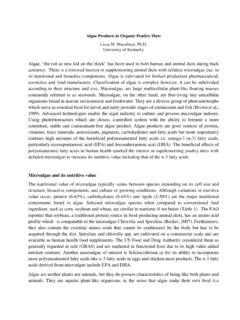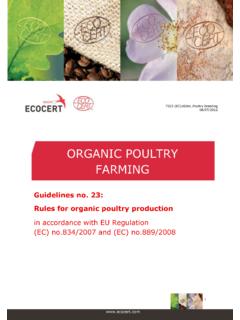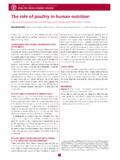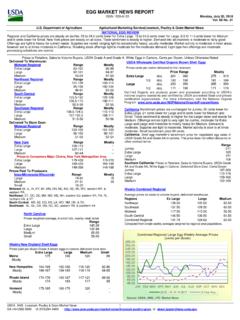Transcription of Cleaning & Disinfection of Poultry Farm
1 Food and Agriculture Organization of the United Nations Cleaning & Disinfection off Poultry P lt Farm F. Y i Segal Yoni S l FAO Consultant y g @ g AI Technical Unit Food and Agriculture Organization of the United Nations Objectives By the end of this session, participants will be able to: Define farm decontamination - Cleaning and Disinfection and explain what each accomplishes Describe different g groups p of disinfectants Describe the safe use of disinfectants and explain the importance of PPE during Cleaning and Disinfection Review the information on a disinfectant by reading and interpretation of a products' label AI Technical Unit Food and Agriculture Organization of the United Nations Cleaning and Disinfection = Decontamination Cleaning and Disinfection are key components of routine biosecurity in Poultry farming Decontamination kills any disease organisms like.
2 Virus bacteria parasite mold that might be present on a farm at the end of a production cycle or after disease outbreak Decontamination allows for safe re-population of a farm AI Technical Unit Food and Agriculture Organization of the United Nations Exercise: The q questions! 1 What is a Poultry farm Cleaning and how its done ? 1. 2. What is a Poultry farm Disinfection and how its done? 3. How do you choose a disinfectant? 4 What are risks involved in using disinfectants and 4. how to avoid them? In your group discuss what do you know about the question Record your key points on the flipchart Be prepared to present your answer to the group Take about 10 minutes to complete this task AI Technical Unit Food and Agriculture Organization of the United Nations Survival of disease causing agents in the environment Disease agent Survival time Avian influenza Days y to months IBD (Gumboro) Months Coccidiosis Months Fowl Cholera Weeks Coryza Hours to days Marek's Disease Months to years Newcastle Disease Days to months Mycoplasma Hours to days Salmonellosis (Pullorum) Weeks AI Technical Unit Food and Agriculture Organization of the United Nations What can kill disease agents?
3 Detergents / soap Disinfectants Sunlight Heat (direct flame or steam). AI Technical Unit Q. Food and Agriculture Organization of the United Nations Cleaning The physical removal of foreign materials like: - dust - soil - organic material such as: droppings, blood, secretions which p protect disease agents g Remember! A good Cleaning job will remove 80% of disease agents AI Technical Unit Food and Agriculture Organization of the United Nations Cleaning - is a two-step process step 1. Dry Cleaning Using a broom, brush, shovel, rag or compressed air to remove dust, soil and dry organic material Remember! e e be Dry Cleaning should not be used for Cleaning Poultry houses infected with air-born air born diseases such as: Avian Influenza or Newcastle it may cause aerosolization of the virus and increase the risk of spreading g the disease AI Technical Unit Food and Agriculture Organization of the United Nations step 2.
4 2. Wet Cleaning Using detergent/soap and water soak the area and scrub to remove remaining organic material as well as dirt and grease For washing you can use common detergent powder sold for cloth laundering is cheap and effective Wet Cleaning reduces the risk of aerosolization of virus AI Technical Unit Food and Agriculture Organization of the United Nations Cleaning is improved with: Detergents / Soaps Warm water Scrubbing B hi Brushing Power washers Steamers AI Technical Unit Food and Agriculture Organization of the United Nations Remember! Disinfectants lose effectiveness during contact with disease agents Organic materials such as manure, blood, dust or dirt absorb disinfectants and makes them less effective O. Organic i materials t i l protect t t disease di agents t You must CLEAN properly before you disinfect! AI Technical Unit Q.
5 Food and Agriculture Organization of the United Nations Disinfection Disinfection might kill the remaining disease agents left after Cleaning g Disinfection is the least reliable step of biosecurity biosecurity, depends on many factors such as: the quality of Cleaning the hardness of water quality and suitability of disinfectant correct dilution and application AI Technical Unit Food and Agriculture Organization of the United Nations What are Disinfectants? Disinfectants are chemicals that - Slow disease agents activity activity, multiplication and their growth or - Kill disease agents AI Technical Unit Food and Agriculture Organization of the United Nations Common types of disinfectants Disinfectants are di divided ided into se several eral gro groups ps based on their chemical structure Like: Halogens (iodophors and chlorines, halamid , dettol ).
6 Alcohols Oxidizing agents (hydrogen-peroxide, hyperox , virkon ). e o s ((fenix , Phenols e , Prophyl op y 75 ). 5 ). Aldehydes (glutheraldhyde TH4 , formalin). Quaternary ammonium compound (Timsen Medisep ). AI Technical Unit Q. Food and Agriculture Organization of the United Nations Ch Choosing i ththe Ri Right ht Di Disinfectant i f t t The choice of disinfectant will depend p on the following: g Cost Type yp of disease agent/s g to be destroyed y Amount of contamination by organic matters such as: droppings, blood and manure left in the Poultry house Active ingredient the chemical compound and concentration that its contained Cont AI Technical Unit Food and Agriculture Organization of the United Nations Dilution and Application rate will determine the proper concentration and application rate of the mixed solution (the correct quantity of disinfectant to be used).
7 Contact time the minimum contact time of the disinfectant with the surface, to allow for killing of the disease agents Safety To p people, p animals, equipment q p and the environment AI Technical Unit Food and Agriculture Organization of the United Nations Reading the label of disinfectants Before using any disinfectant the label MUST be red and understood understood. The Th label l b l gives i you valuable l bl iinformation. f ti AI Technical Unit Signal HeadingFood and Agriculture Organization of the United Nations CAUTION or WARNING - Slightly toxic = S5. POISON - Highly toxic = S6. DANGEROUS POISON - Extremely toxic = S7. AI Technical Unit Food and Agriculture Organization of the United Nations Active Ingredient AI Technical Unit Food and Agriculture Organization of the United Nations Directions for Use AI Technical Unit Food and Agriculture Organization of the United Nations Safety Directions AI Technical Unit Food and Agriculture Organization of the United Nations First Aid For additional information look at AI Technical Unit Food and Agriculture Organization of the United Nations Reading the Label Look at the labels provided Complete the questions Product Name Active ingredient Rate of Mixing Toxicity Level 1.
8 2. 3. AI Technical Unit Q. Food and Agriculture Organization of the United Nations Disinfectants are Dangerous ! Disinfectants are dangerous chemicals = poisons We have to be careful when we use disinfectants Disinfectants might g cause p poisoning: g Acute (fast) toxicity with certain disinfectants may cause: dizziness, nausea and itchy eyes or skin Chronic (slow) toxicity may occur gradually over many years, years may cause: permanent disability because the body has become very sensitive AI Technical Unit Food and Agriculture Organization of the United Nations How dangerous a disinfectant is? Depends on: The type of substance and what it is made of The speed p and the way y it enters the body y The amount of substance that enters the body AI Technical Unit Food and Agriculture Organization of the United Nations Absorption rate Scalp = Forehead = Ear = 54.
9 Eyes = 12. Nose = 6. Palm = Arm = 1. Abdomen = 2. Feet = 2. Groin = 11. A splash in the eyes is absorbed 12 times faster than a splash on the arm AI Technical Unit Food and Agriculture Organization of the United Nations Poisoning Chemicals can enter your body through 3 ways: 1. through the lungs when breathing or smoking 2. through the mouth when eating and drinking 3. through the skin and eyes Remember! When handling chemicals you need to make sure you wear the right g clothes and equipment q p for yyour p protection AI Technical Unit Food and Agriculture Organization of the United Nations Protect your Mouth and Lungs Breathing in disinfectant vapors or spray particles The main danger exist when: Mixing Mi i chemicals h i l Spraying in confined spaces Using fumigants such as formaldehyde or chlorine Accidental drinking of chemical by drinking (by children).
10 AI Technical Unit Food and Agriculture Organization of the United Nations W. Wear respirators i t If the label states a respirator to be worn then TOXIC vapors will be released. You must use a full face or half face respirator p fitted with appropriate filters Remember! Dust or biological masks are not designed to p y droplets filter chemical's spray p and vapors p AI Technical Unit Food and Agriculture Organization of the United Nations Eye Protection C. Contamination t i ti off th the eyes can resultlt ffrom: drift, splash or spill of chemicals rubbing bbi eyes with ith contaminated t i t dh hands d or clothing l thi Chemical Ch i l absorbed b b d th through h th the eye very rapidly idl Al Always wear eye protection t ti when h handling h dli or spraying i chemicals Use: goggles or face shield AI Technical Unit Food and Agriculture Organization of the United Nations Skin Absorption Absorption is highest when temperature is hot and skin is perspiring (hot season).


















